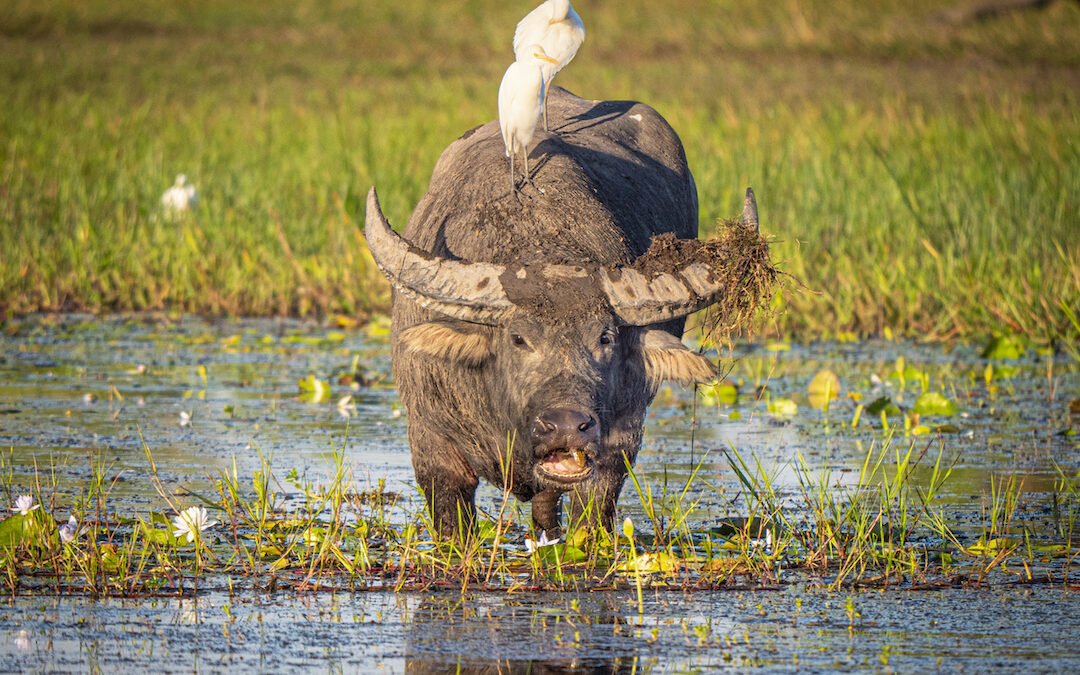Controlling feral animals could be the solution for lowering methane emissions.
Researchers from Charles Darwin University have found that the control of feral buffaloes could save millions in carbon offsets, revitalising the economic standing of these important control programs.
Previously, controlling feral water buffalos in the Northern Territory has been proven useful in protecting local ecosystems. However, while environmentally significant, these programs suffer from a lack of funding, making them impossible to maintain for a long period of time.
However, this new research from Charles Darwin University suggests there’s another way. If it were possible to reduce carbon emissions by culling feral animals, control programs could save money and continue to protect Australia’s environment.

The problem with water buffaloes
Water buffaloes were first brought to Australia in the early 1800s for meat. However, they eventually spread and colonised the swamps and freshwater springs in the top of the Northern Territory, where they had access to plenty of food and water.
Feral buffaloes have been a disaster for the local environment ever since, causing soil erosion and channelling floodwaters due to their trampling and disturbance. The buffaloes eat large amounts of grass and plants, limiting access to the same food for native animals, as well as promoting the spread of weeds. They can also carry diseases of cattle, such as tuberculosis.
Like other animals such as camels, goats and deer, water buffalos produce methane during digestion, letting this greenhouse gas into the atmosphere and contributing to global warming.
The animal answer
Acknowledging the negative impact of water buffaloes, researchers created a 20-year simulation of feral water buffalo populations, tracking how much methane production would be avoided in a region near the Kakadu National Park if the feral buffaloes were removed.
The study was published in Wildlife Research, concluding that the cost of controlling water buffaloes was significantly less than the money being spent on aerial operations targeting methane emissions. This means, if water buffaloes are targeted and removed, both money and the environment would be saved.
Lead author of the study, Hugh Davies, said this wasn’t about individual ‘bounties,’ but exploring ways to encourage the control of feral populations.
“We’re looking at how feral animal control programs impact future populations and what that means for methane emissions over the next 20 years,” he said.
“This research is an important proof of concept that ongoing feral ruminant control could be financially viable.”
If feral buffaloes aren’t controlled, the modelling indicates methane production in the study area would increase to 97,282 tonnes a year. However, if buffalo numbers were limites, scientists could prevent the release of more than 790,000 tonnes of greenhouse gases over the 20-year simulation.
This reduction of carbon emissions would save more than $1 million per year, money which could be funnelled into other projects hoping to protect our environment.

Looking forward
However, while this study seems like a safe and easy solution, Dr Davies warned that more research is needed before any action can be taken. For one, the simulation was based on assumptions such as the carrying capacity of the landscape, which would have to be tested further to ensure the calculations were correct.
“This is just the start of the research, but it throws up some ideas we should consider in carbon offsets,” he said.
“This approach could incentivise the control of numerous destructive feral animals which have often been put in the too hard basket – such as feral camels in the outback, or the booming feral deer populations in Victoria, NSW and Tassie. This is an exciting prospect. It changes everything and would have massive ecological benefits.
Dr Davies has experience as a mammal conservation expert, and has seen the damage feral animals have done to the environment in the Northern Territory. The research completed by him and the team of experts could have major benefits along the track, helping to fight climate change and protect Australia’s precious environment.
To read the research paper, click here.
To learn more about ways to protect the environment, click here.

